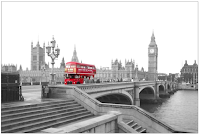Cases study 10 : The Red Bus case

The Red Bus case about images of a London bus crossing Westminster Bridge in front of the iconic Houses of Parliament. Temple Island Collections used one image on souvenirs of London, while New English Teas ( a brand of tea ), used the other image on tea packaging. image1 Temple Island Collections which produces souvenirs of London, claimed to be the owner of copyright which subsisted in a black and white photograph of a red bus travelling across Westminster Bridge . ( up) The image as 'largely in black and white, with the Houses of Parliament and the bridge shown in grey. The sky is white, with nothing else can see. A bright red London Routemaster bus stands out on the bridge'. Image 1 was created by Mr Fielder after manipulating a photo he took with Photoshop software and was first published in February 2006. Image2 New English Teas (NET), as its name suggests, produces tea. It wished to use an image which Judge described as containing 'thes